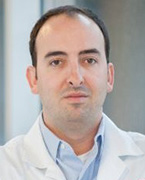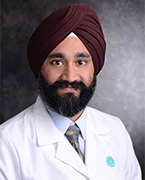From Spine Surgery to Epilepsy Diagnosis, Even the Best Care Can Get Better
At Atrium Health’s Neurosciences Institute, we’re not satisfied with being home to some of the nation’s top experts, or with delivering some of the region’s best outcomes. Rather, we’re on a mission to make care even better. That’s why we’re always on the lookout for technologies that transform treatment, and why we routinely make big investments to bring those advances to our patients.
Case in point: We were among the first to embrace a groundbreaking system that’s making spine surgery less invasive and more accurate, and we’re at the forefront of using revolutionary technology to pinpoint where seizures start.
Making Spine Surgery More Precise
Our use of a new GPS-guided, robotic-assisted system illustrates how innovative technology can make the best surgeons even better. It’s the first system to integrate state-of-the-art intraoperative imaging, real-time GPS guidance and a robotic arm. And it’s helping our spine surgeons make ultra-precise screw placements and reduce complications.
We start by taking CT images of a patient’s spine and entering them into the new system. Then the system’s software creates a map of the patient’s anatomy, allowing the surgeon to plan an ideal trajectory for each screw.
During surgery, the robotic arm zeroes in on that trajectory to guide screws to the right location. By adapting to a patient’s breathing and other slight movements, the GPS guidance helps the system stay locked in. This keeps our surgeons on target as they perform the actual surgical tasks, like drilling bone and inserting screws.
Thanks to this innovative system, screws can be placed with greater than 99 percent accuracy, compared to 80 to 95 percent accuracy with traditional techniques. In fact, the robotic-assisted system is so precise that we’re also pioneering its use in cervical spine procedures.
The results? Smaller incisions, less muscle damage – and a lower risk of complications such as spinal fluid leaks or neural injury. What’s more, the improved surgery can translate into shorter recovery times so patients can get back to healthier, more active lives.
Helping More Epilepsy Patients Find Cures
Patients come from across the region to see our world-class epileptologists, drawn partly by our reputation for helping people who have endured seizures for years. A key challenge with these patients is identifying where their seizures originate. That’s why we built a state-of-the-art neurodiagnostic laboratory and were early adopters of 3T MRI brain imaging, PET and SPECT scans, as well as advanced software for seizure-focus localization, tracking and trending.
More recently, we were one of the Southeast’s first centers to offer stereoelectroencephalography (SEEG). SEEG involves placing electrodes into the brain through small skull openings. This is far less invasive than the traditional method of doing a craniotomy and placing a subdural grid on the surface of the brain. SEEG also enables us to cover larger brain areas, reach deeper parts of the brain, and identify the origins of seizures that come from both hemispheres.
The best part? SEEG is helping us localize seizure onset in more patients than ever – and perform resections that eradicate seizures in patients who thought a cure was out of reach.
We’re Here to Help Your Patients
We’re eager to work hand in hand with you to use these technologies to help your patients lead happier, healthier lives. And we’re already evaluating the next wave of potentially game-changing advances, like intraoperative MRI and 3-D intraoperative advanced visualization, so we can continue applying a high-tech approach to an age-old goal: giving each patient the best chance at a good outcome.
For more information or to refer a patient, call 704-512-7878.



